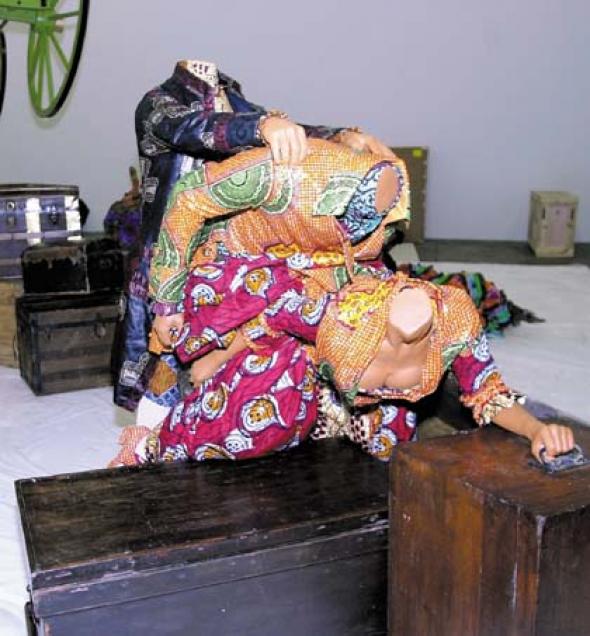Documenta Dreaming
The scale and standing of Documenta, Kassel’s four-yearly art bonanza, guarantee its cultural impact almost irrespective of its curatorial agenda. But even by these standards, Documenta 11 has managed to be a watershed exhibition. Adored and attacked in equal measure for his vision of a politicised aesthetics for the globalised world, Maria Fernandez found that director Okwui Enwezor provided a welcome curatorial corrective.
Before leaving California to visit Documenta 11, I had a conversation with a colleague from New York who had attended the opening. ‘Do not go’, she warned, ‘I do not think that show merits either the expense or the effort.’ ‘Why not?’ I inquired, ‘is it because you find it too political?’ ‘No’ she said. ‘It is just uninteresting. All that Enwezor claims to do was better achieved by Catherine David in Documenta X.’ My colleague’s opinion has been reiterated in multiple reviews of Documenta 11, ranging from educated critiques of the exhibition’s aesthetic and conceptual bases, to virulent attacks on Okwui Enwezor, the chief curator.
The much-debated exhibition in Kassel is the last of five platforms of conferences and workshops designed with the aim of displacing Documenta’s Eurocentrality both spatially and in a cultural-historical sense[1]. In addition to ‘deterritorialising’ the exhibition, Enwezor proposed to question universalising conceptions of cultural and artistic modernity as well as the notion of the autonomy of art from all political and social demands.’[2]
Indeed, these objectives do parallel those of Documenta X, an exhibition that championed ‘the political potential of art’ as one of its primary concerns. Contrary to my New York colleague, I found Documenta 11 to be supplementary rather than imitative and redundant in relation to Documenta X.
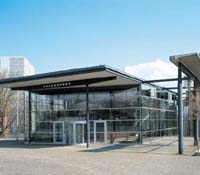 > Documenta Hall, exterior view. Photo: Werner Maschmann ---------------------------------------------------------------------------------Documenta 11 expands the parameters of Documenta X, developing a project only commenced by Catherine David. She undertook the important initiative of integrating the context of artistic production to the study of contemporary art. To achieve this aim, Documenta X introduced a wealth of theoretical materials to a reluctant German art world. The catalogue featured texts by significant theorists including Gramsci, Foucault, Deleuze, Said, Fanon, Braudel, and Clastres. Topics of discussion included globalisation, postcoloniality, the world economies, and the social and cultural changes brought about by electronic technologies. The examination of these topics in theory implied that the study of art history should be expanded beyond the object, beyond traditional geographical categories, and beyond the conventional limits of the discipline. This was especially evident in the 100 Days lectures in which artists, critics and theorists participated. As the curator admitted, the exhibition could not cover all the areas mapped by its broad theoretical foundations and thus, with the exception of selected areas of Asia, its focus remained on Europe. The inclusion of Caribbean, Vietnamese and African cinema in the exhibition catalogue, however indicated the necessity of a more global vision.
> Documenta Hall, exterior view. Photo: Werner Maschmann ---------------------------------------------------------------------------------Documenta 11 expands the parameters of Documenta X, developing a project only commenced by Catherine David. She undertook the important initiative of integrating the context of artistic production to the study of contemporary art. To achieve this aim, Documenta X introduced a wealth of theoretical materials to a reluctant German art world. The catalogue featured texts by significant theorists including Gramsci, Foucault, Deleuze, Said, Fanon, Braudel, and Clastres. Topics of discussion included globalisation, postcoloniality, the world economies, and the social and cultural changes brought about by electronic technologies. The examination of these topics in theory implied that the study of art history should be expanded beyond the object, beyond traditional geographical categories, and beyond the conventional limits of the discipline. This was especially evident in the 100 Days lectures in which artists, critics and theorists participated. As the curator admitted, the exhibition could not cover all the areas mapped by its broad theoretical foundations and thus, with the exception of selected areas of Asia, its focus remained on Europe. The inclusion of Caribbean, Vietnamese and African cinema in the exhibition catalogue, however indicated the necessity of a more global vision.
Documenta 11 presents concrete examples of art that responds to the political and economic challenges identified in Documenta X. It takes seriously the task to examine artistic production in the context of globalisation, though as the previous Documenta, and for that matter any exhibition, it fails to represent the entire globe. Like Documenta X, Documenta 11 presents art produced from the late ‘50s to the present and includes artists such as Hanne Darboven, who was already represented in previous Documentas. This contributes to a sense of continuity with the previous exhibition. Documenta 11 showcases a great variety of works with marked preference towards conceptual art and the narrative and documentary genres of photography, film, and video. Despite the multiplicity of works and approaches, some themes persist. Various artists explore issues of systematisation and categorisation, as well as the impossibility of regulating, systematising and abstracting specific phenomena. Often, the two tendencies occur in a single work as if to illustrate the subjective nature of classification. A good example is Berndt and Hilla Becher’s photographic series Half Timbered Houses of the Siegen Industrial Zone (1958- 1973), which consists of about two hundred photographs of buildings categorised by type according to formal features such as gable ends, rear walls, or type of view, including street fronts and corner views. The variety of criteria for classification suggests infinite possibilities for the creation of new classes, ultimately implying the openendedness of the system.
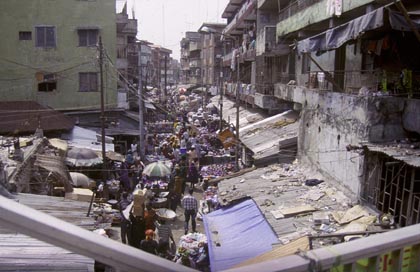 > Olumuyiwa Olamide Osifuye, Image from a photo-essay of Lagos, Nigeria, 2002 Colour photograph Courtesy of the artist
> Olumuyiwa Olamide Osifuye, Image from a photo-essay of Lagos, Nigeria, 2002 Colour photograph Courtesy of the artist
On Kawara, One Million Years past 998.031 BC to 1969 AD One Million Years Future 1999 to 1.001.998 AD consists of a series of texts recording the passing of every year between the dates specified in the title. The work illustrates the systematisation and abstraction of memory and experience. The reading of these texts in hourly performances introduces an element of instability into the system as each number is read in a different manner and the duration between the reading of one number and the next varies. In hundreds of small ink and pencil drawings surrounded by text, Frederic Bruly Bouabre records various systems of meaning foreign to most western observers. These include scarification, orange rind and cloud patterns, Akan goldweights, used as visual aids to evoke complex oral traditions, and a divination system based on arrangements of Kola nuts. His systematic study and explication of these signs interrogates the notion of intelligibility and ultimately suggests the relativity of all signification systems.
The incongruities between abstractions and lived experiences are emphasised in From/to 2002 by Palestinian-American artist Fareed Armaly, in collaboration with Palestinian filmmaker Rashid Masharawi. A large installation spanning two rooms and part of a hallway at Documenta Hall, From/to 2002 contrasts official cartographic representations of the Israeli-Palestinian conflict with daily experiences of Palestinians in various settings as depicted in three of Masharawi’s films. The central film Checkpoint illustrates the frustrating and time consuming experience of travellers required to stop at military checkpoints distributed throughout the occupied territories. The film relates to the maps in documenting an official technique to control perceptions of geographical space. As Masharawi’s films include narratives developed by Palestinians in Diaspora, From/to 2002 also concerns the continuation and transformations of Palestinian history and the development of new forms of agency.
Documenta 11 examines economic, social and political impacts of globalisation, giving special attention to Africa, Latin America and India, areas of the world under-represented in Documenta X. Few works address globalisation directly. Of these, Fabian Marcaccio’s Multiple Sites Paintants, billboard-like architectural constructions integrating dynamic abstraction with images of corporate environments, production sites, and urban unrest and repression stands out, as does Andreas Siekman, From: Limited Liability Company, a collection of over 200 drawings made between 1996 and 2002 which feature blue jeans as visual markers to address the impact of globalisation on urban space.
More numerous are works that reveal the underside of the corporate rhetoric of open markets, efficiency, and consumer choice. Films by Ulrike Ottinger and Pavel Braila illustrate economic and cultural inequalities between Western and Eastern Europe. Ottinger’s South East Passage (2002) records a trip from Berlin to Eastern Europe and of two individual visits, one to Odessa and another one to Istanbul. Braila’s Shoes for Europe (2002) documents the three-hour, labour-intensive process of changing the wheels from Russian to standard gauge that trains must undergo at the Moldavian-Romanian border. Both films provide vivid and moving images of places and peoples dislocated from Western modernity and overdevelopment.
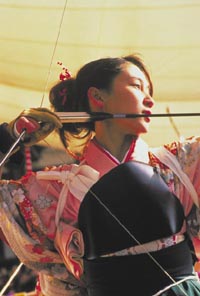 > Fiona Tan Saint Sebastian, 2001 Video installation, video stills Courtesy of the artist --------------------------------------------------------------------------------------------------Nigerian photographer Olumuyiwa Olamide Osifuye and Cameroon-born installation artist Pascale Marthine Tayou portray the vibrancy, unmanageability, and technological diversity of African cities as well as the resilience and resourcefulness of African peoples. Osifuye’s photographs of aspects of everyday life in Lagos, his native city, include overcrowded streets, traffic jams, markets and vendors. In Tayou’s video installation, Game Station (2002), ten monitors screen daily events in Jaunde, Cameroon: women collect water from a broken street pipe, a group of men push a broken car in an unpaved road, three women ride and eat ice cream in a mud-covered taxi, urban rappers perform. Radio sounds accompanying the videos, create cacophony in the exhibition space and attest to the confluence of modernity and underdevelopment typical of global cities.
> Fiona Tan Saint Sebastian, 2001 Video installation, video stills Courtesy of the artist --------------------------------------------------------------------------------------------------Nigerian photographer Olumuyiwa Olamide Osifuye and Cameroon-born installation artist Pascale Marthine Tayou portray the vibrancy, unmanageability, and technological diversity of African cities as well as the resilience and resourcefulness of African peoples. Osifuye’s photographs of aspects of everyday life in Lagos, his native city, include overcrowded streets, traffic jams, markets and vendors. In Tayou’s video installation, Game Station (2002), ten monitors screen daily events in Jaunde, Cameroon: women collect water from a broken street pipe, a group of men push a broken car in an unpaved road, three women ride and eat ice cream in a mud-covered taxi, urban rappers perform. Radio sounds accompanying the videos, create cacophony in the exhibition space and attest to the confluence of modernity and underdevelopment typical of global cities.
The video installation Flow (2002) by Igor and Svetlana Kopystianky follows the journey in a waterway of refuse such as plastic bags and bottles, surgical gloves and cartons, alluding to the devastation of ecological environments by contemporary practices of garbage disposal and littering. This theme is extended in Michael Ashkin’s photographic project, Untitled (New Jersey Medowlands Project, 2001-2002) depicting a decaying, polluted suburban landscape in which the most viable buildings are gas stations. South African photographer David Goldblatt illustrates land speculation by corporate developers and the destitution of former inhabitants in the process. In one photograph, for example, a suburban ‘gulf state and country club’ spreads behind a fragile shantytown. Although Goldblatt’s photographs depict suburbs of Johannesburg, the phenomenon of land appropriation is ubiquitous.
Many works in Documenta 11 refer to the violence rampant in most of the world due to religious, social, economic or political inequalities. The subjects of these works range from urban unrest in England (Black Audio Film Collective, Handsworth Songs, 1986) to political repression in South America (Doris Salcedo, November 6, 2001, Luis Camnitzer, From the Uruguayan Torture series, 1983/84, Gaston A. Ancelovici, Colectiva Cine Ojo, Memorias de una guerra cotidiana, 1986); India (Amar Kanwar’s A Season Outside, 1997); the Middle East (Fareed Armaly, and Rashid Masharawi From/to 2002, The Atlas Group’s fictitious archives); and various parts of Africa (Eyal Sivan, Itsembatsemba-Rwanda One Genocide Later, 1996 Zarina Bhimji’s film on Uganda, Santu Mofokeng’s photographs of South African prisons). Although many works have documentary aspects, others are conceptual or lyrical, suggesting the active roles of the imagination, affect and memory in the representation of events.
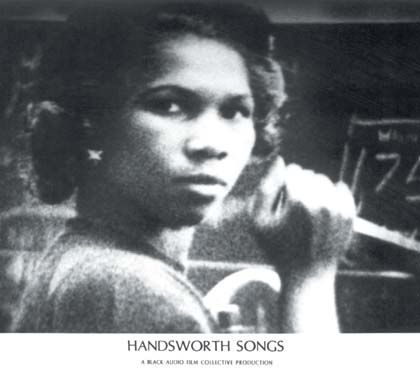 > Black Audio Film Collective, Handsworth Songs, 1986 colour, 60 min. Directed by John Akomfrah, produced by Linda Gopaul Courtesy Smoking Dogs films, London
> Black Audio Film Collective, Handsworth Songs, 1986 colour, 60 min. Directed by John Akomfrah, produced by Linda Gopaul Courtesy Smoking Dogs films, London
Various artists investigate the experience of migration and exile and the material and emotional realities of a changing Europe. Fiona Tan’s filmic installation Countenance (2002) looks at German faces through the eyes of a newly arrived immigrant from Indonesia, reversing the customary role of the western anthropologist studying non-western peoples. The installation ID: A Journey Through a Solid Sea by the collective Multiplicity, presents various perspectives on the disaster of the Yiohan, a Greek-owned ship which sank in unclear circumstances along with its cargo of 260 illegal immigrants in December 1996. The collective’s research into the incident underlines the fragility of the lives of illegal immigrants and the challenges that immigration poses to traditional concepts of identity for both immigrants and Europeans. The five hour long film by Johan van der Keuken, Amsterdam Global Village, (1996), presented as part of Documenta 11’s film series, uncovers multiple ethnicities at the heart of contemporary Dutch culture and traces intricate global networks generated by recent immigrants. Isaac Julien’s multi screen installation, Paradise Omeros (2002) presents a poetic, allegorical reflection on the promises of migration, and the experiences of displacement, estrangement and racial tension.
Unwilling to concentrate on the problems of the world without considering possibilities for change, the curators of Documenta 11 invited various activist artist projects including Maria Eichhorn’s Limited Company, a corporation that opposes capital gains; texts and videos on peaceful activism by Le Group Amos, Congo Kinshasa; the collective Park Fiction’s documentation of a community’s reclamation of urban space in Hamburg and Julie Bergman and Stacie Levy’s Testing the Waters (1995), a project of ecological regeneration in a polluted area of Pennsylvania. Many of the architectural projects in Documenta 11 explore alternatives for the design and construction of cities and are to that extent utopic. These projects include Isa Genzhen’s, New Buildings for Berlin (2000), Bodys Isek Kingelez, Kimbembele ihunga-Kimbevile (1994), Constant, New Babylon (1956-1974), and Yona Friedman, Spatial City (1958-1962).
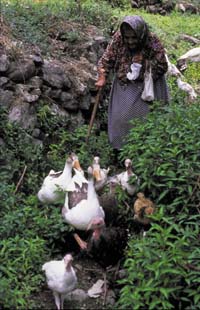 > Urike Ottinger, Southeast Passage. A Journey to New Blank Spots on the Map of Europe, Wrocaw–Varna/Odessa/Istanbul, 2002. Production still Film: DV-Cam / Digibeta, colour and black and white, 360 min: 1st part: 130 min., Wrocaw–Varna; 2nd part: 140 Min., Odessa; 3rd part: 90 Min., Istanbul - © Ulrike Ottinger 2002 Courtesy the artist. ------------------------------------------------------------------------------------------Although many works in Documenta 11 were made during the last five years and some were commissioned especially for the exhibition, the presence of digital art was minimal. Various critics attribute this absence either to conservatism or to ignorance of new media on the part of the curators. Few entertain the possibility that video may be a favoured medium in many parts of the world, or that digital practices may still be a largely Euro-American and Japanese phenomenon due to technological inequalities. The acceptance and dissemination of such media technologies are mediated by economic, cultural and political realities. In the US, for example, technologies are valorised as art only when they cease to be new. Photography was only recognised as a serious art form nearly one hundred years after its invention. Until recently, video installations dominated the American and European art worlds to such an extent as to be identified as ‘a homogenising lingua franca of internationalism.’[3]
> Urike Ottinger, Southeast Passage. A Journey to New Blank Spots on the Map of Europe, Wrocaw–Varna/Odessa/Istanbul, 2002. Production still Film: DV-Cam / Digibeta, colour and black and white, 360 min: 1st part: 130 min., Wrocaw–Varna; 2nd part: 140 Min., Odessa; 3rd part: 90 Min., Istanbul - © Ulrike Ottinger 2002 Courtesy the artist. ------------------------------------------------------------------------------------------Although many works in Documenta 11 were made during the last five years and some were commissioned especially for the exhibition, the presence of digital art was minimal. Various critics attribute this absence either to conservatism or to ignorance of new media on the part of the curators. Few entertain the possibility that video may be a favoured medium in many parts of the world, or that digital practices may still be a largely Euro-American and Japanese phenomenon due to technological inequalities. The acceptance and dissemination of such media technologies are mediated by economic, cultural and political realities. In the US, for example, technologies are valorised as art only when they cease to be new. Photography was only recognised as a serious art form nearly one hundred years after its invention. Until recently, video installations dominated the American and European art worlds to such an extent as to be identified as ‘a homogenising lingua franca of internationalism.’[3]
What was puzzling at Documenta 11 was not so much the curatorial predilection for moving image installations, but the justification of this choice in the catalogue essays. There seemed to be consensus among several of the essayists on the interactive potential of installations because they allow the viewer freedom of movement.[4] Jean Fisher explains: ‘the installation can incorporate multiple spatial/geographical and historical/temporal dimensions. It potentially enables a degree of interactivity with the viewer, returning some agency to it with respect to the construction of meaning from various contents in differing sequences.’[5]
If interactivity was a main concern, the scarcity of computer based interactive work remains unexplained. Interactive video and cinema allow the user to determine specific aspects of a work, such as narrative sequence, length and form of closure. Thus, the user is assumed to partake in the creation of the work. The preservation of an authorial voice and designated narrative seems crucial in Documenta 11 as many works lend presence to individuals and groups previously rendered silent or invisible. This priority seems outdated in a world where ‘the death of the author’ has been dogma for the last thirty years. Documenta 11 also reintroduces the testimonial potential of images as a subject for reconsideration. This contradicts our acceptance of a post-indexical, simulacral era from which there is neither respite nor escape. As computer technology facilitates infinite fabrications and recombinations of images, the image has been rendered impotent in its capacity to represent. For the last two decades, multiple artists have resorted to mimicry of the prevalent modes of image production as activist interventions, presumably because it is more efficient to work within the dominant systems rather than against them. Documenta 11 demands the imagination of other forms of intervention even if this involves recuperating old tactics. Despite the tendency of various critics to read the exhibition as dogmatic, proselytising and naive in its assumption that images represent truths, in Documenta 11 both the representative potential of images and the role of artists as witnesses are presented as questions. Many works in the exhibition involve narration, which inevitably intersects with memory and fiction. Ultimately, the issue is not whether images have the capacity to represent ‘truths’ but rather whether they can stimulate ethical reflections and practices. This is not to suggest that this should be the aim of all art but it is one of the stated objectives of Documenta 11. According to Enwezor: ‘Documenta 11’s spectacular difference is that its critical spaces are not places for the normalisation or uniformisation of all artistic visions on their way to institutional beautification... Documenta 11’s spaces are to be seen as forums of committed ethical and intellectual reflection on the possibilities of rethinking the historical procedures that are part of its contradictory heritage of grand conclusions.’[6] Unless one wishes to argue for the conceptual and aesthetic consistency of all Documentas over time, the goals of Documenta 11 should be allowed, if not welcomed.
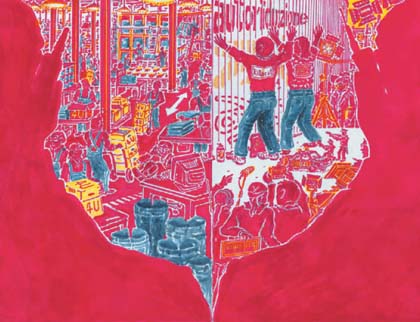 > Andreas Siekmann from: Limited Liability Company, 1996–2002 Motif 1 and 3 / Posters, three motifs, on changing billboards in the public space of Kassel Courtesy the artist/ Galerie Barbara Weiss, Berlin
> Andreas Siekmann from: Limited Liability Company, 1996–2002 Motif 1 and 3 / Posters, three motifs, on changing billboards in the public space of Kassel Courtesy the artist/ Galerie Barbara Weiss, Berlin
Some critics have directed their objections to the presumed limitations of postcolonial theory, as it is believed to be the invention of British ex-colonials with little conception of cultural dynamics in other parts of the world.[7] These critiques seem based on unfamiliarity with the postcolonial discourses developed over the last two centuries, as well as with the impact of more recent postcolonial theory in fields such as geography, anthropology, history, art history, ethnic and border studies during the last twenty years. In these criticisms, postcolonial theory in fact seems to share the static qualities traditionally attributed to all things primitive as it is portrayed as rigid and unchanging.
For me, the most disappointing part of Documenta 11 was the catalogue. For an exhibition that places so much emphasis on the ‘interactive’ aspects of moving image installations, a massive collection of still images is an inadequate choice. As discussed above, some of the essays attempt to justify the choice of the exhibition’s prevalent media but do so poorly.
Other current European exhibitions explore themes that intersect with Documenta 11. Iconoclash, curated by Peter Weibel at the ZKM in Karlsruhe contrasts the iconoclasm prevalent in contemporary art with the trust placed on scientific imagery. In Weibel’s view, ‘to be able to maintain its significance up against the sciences and their picture-producing procedures, art must look for a position beyond the crisis of representation and beyond the image wars.’[8] As Documenta 11, this exhibition re-examines the representative potentialities of images.
The Ars Electronica Festival in Linz (see ‘Pull the Plug’ by Armin Medosch in this issue, p. 116), Austria was entitled ‘Unplugged: Art as the Scene of Global Conflicts.’ Here, the art exhibitions illustrated the difficulty of curating a globally inclusive show of digital media. Despite the predominantly African focus on the symposium panels, African work in the exhibition was limited to music, film, video and folk art, displayed on tables and in video. Tonga.Online, a project initiated by an Austrian group provided access to the internet to the Tonga peoples of the Zambezi valley giving them an opportunity to communicate and represent themselves. The focus of the project is traditional Tonga music, which on special occasions is played with antelope horns.
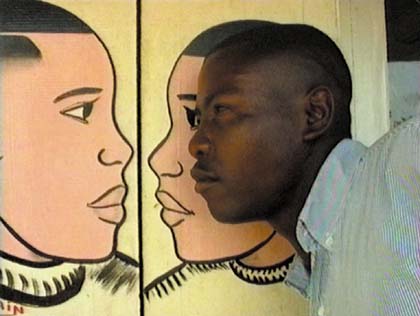 > Pascale Marthine Tayou Game Station, 2002 Stills from Installation, mixed media Courtesy the artist
> Pascale Marthine Tayou Game Station, 2002 Stills from Installation, mixed media Courtesy the artist
The Crossing Project by Ranjit Makkuni, a researcher, designer and musician at Xerox Palo Alto Research Center, won a Prix Ars Electronica for Interactive Art. The work attempts to integrate ubiquitous computing technology with traditional Indian arts and crafts using common objects – a rickshaw, a box, a jacket – as interfaces to access a variety of images. The artist explained his project as a way to compensate for technological inequalities, ‘You may not have an LCD screen but you always have a jacket’. Texts on the walls around the installation included directions such as: ‘Explore the stories on the streets of Banaras [sic.] by steering the handle of a rickshaw’.... ‘Click on the hotspots on the jacket and discover how the yogi internalises the outer ecological elements such as water, wind, and solar energy in his subtle body. Contrary to the artist’s explanations, the texts suggested that the work be used not by the local people but by virtual tourists. In Mr. Makkuni’s words, ‘As computer technology proliferates in the world, retaining identity becomes an important value in the new millennium...’ the project recreates forms that ‘capture a civilisation’s primal symbols animated through embedded technology.’[9] Wearing a cotton tunic, the artist concluded his presentation at the Prix Ars Electronica panel on interactive art with a concert of Indian music. Sadly, such exoticist displays throughout the event bring to mind the colonialist excesses of nineteenth century world fairs.
Despite the use of sophisticated technology, this artist and his work reaffirm both stereotypical notions of other cultures as exotic entities to be consumed, as well as the assumption, dominant even in progressive circles, that non-western peoples uphold rigid concepts of identity markedly different from their nomadic, border-crossing western counterparts. As various scholars have demonstrated, traditional concepts of gender, ethnicity and race survive in new technological realms.[10] Thus, the use of new technologies does not necessarily guarantee progressive or radical content; quite often the opposite is true.
Documenta 11 presents non-westerners as critical and active agents. Its focus on globalisation and postcoloniality challenges stereotypical notions of difference between ‘us’ and ‘them’. In the context of Fortress Europe and the War on Terror, perhaps it is this problematisation of distance, (achieved, ironically, by outdated imaging technologies) that makes the exhibition indigestible to some. Between tokenistic exoticism and Documenta 11, I vote for the later, warts and all.
[1] Okwui Enwezor ‘The Black Box,’ in Documenta 11_ Platform 5: Exhibition Catalogue (Kassel: Hatje Cantz Publishers, 2002), 42
[2] Ibid, 43
[3] Jean Fisher, ‘Toward a Metaphysics of Shit’ in Documenta 11_ Platform 5: Exhibition Catalogue, 69
[4] Boris Groys cited by Mark Nash ‘Art and Cinema, Some Critical Reflections,’ in Documenta 11_ Platform 5: Exhibition Catalogue, 130
[5] Jean Fisher, ‘Metaphysics of Shit,’ 68
[6] Okwui Enwezor, ‘Black Box,’ 43
[7] Florian Cramer, Re: <nettime> a modest proposal for josephine bosma, Nettime, Tue, Aug 27, 2002, 4:30 pm
[8] Exhibition caption
[9] Ranjitt Makkuni, ‘The Crossing Project’ in Prix Ars Electronica 2002 Cyberarts, edited by Hannes Leopoldseder and Christine Schoepf (Germany, Hatje Cantz publishers, 2002)
[10] See for example, Race in Cyberspace edited by Beth Kolko, Lisa Nakamura and Gilbert B. Rodman (New York: Routledge, 2000) and Domain Errors/ Cyberfeminist Practices edited by Maria Fernandez, Faith Wilding and Michelle Wright (forthcoming, Autonomedia)
Maria Fernandez <Xochipilli AT compuserve.com> is an art historian (Ph.D. Columbia University, 1993) whose interests centre on postcolonial studies, electronic media theory, Latin American art and the intersection of these fields.
Mute Books Orders
For Mute Books distribution contact Anagram Books
contact@anagrambooks.com
For online purchases visit anagrambooks.com


